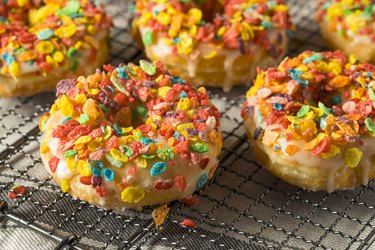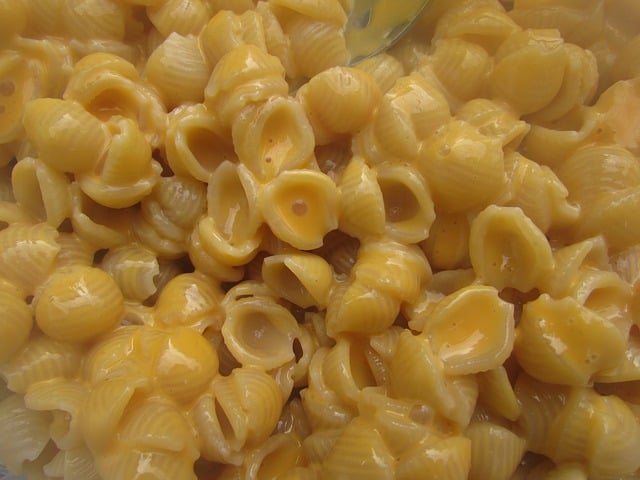It’s worth noting, perhaps, that these brands made these changes only after a study found that many name brand foods, including those owned by General Mills and Kraft, contained dyes in amounts higher than the levels demonstrated in some clinical trials to impair some children’s behavior, according to the CSPI.
Is the Food Dye Red 40 Dangerous to Your Health?

While some people are skeptical of food dyes, specifically Red No. 40, formally known as Allura Red AC, the FDA deems the additive to be safe and regulates its use in food.
Still, other organizations, including the Center for Science in the Public Interest (CSPI) consider Red Dye 40 potentially harmful (particularly to children). One thing experts can agree on is that Red Dye 40 has been highly controversial throughout the years.
Video of the Day
Tip
The Food and Drug Administration deems Red Dye 40 to be safe and regulates its use in food; however, other organizations, such as the Center for Science in the Public Interest, believe it to be carcinogenic.
What Is Red Dye 40?
As a color additive, Red Dye 40 is used by manufacturers to give products — including food, drugs and cosmetics — a certain appearance, according to the FDA. When it comes to food, color additives can either enhance the food’s natural color, give color to a food that doesn’t have color or help give a flavored food a certain identity.
For example, think of the last time you ate something that was strawberry-flavored, such as candy or yogurt. It might not have had any real strawberry in it (or not enough to give it an enticing red color), so the manufacturer used Red No. 40 to turn it pinkish red to help you associate it with strawberries.
Red Dye, like most artificial dyes, is derived from petroleum, per the CSPI.
Foods With Red Dye 40
Red Dye 40 can be found in a multitude of foods It is classified as a synthetic or artificial coloring rather than a natural coloring, which are derived from plants, animals or minerals.
The following foods are some of the more common sources of Red Dye 40, according to the FDA:
- Cereal
- Beverages
- Gelatins
- Puddings
- Dairy products
- Sweets and baked goods
Red Dye 40 is eaten most often by children and, as such, it shows up in a lot of children’s foods (think flavored milks and yogurts, colorful desserts and snacks and saccharine drinks).
Children ages two to five ate the most Red Dye 40 per day, according to a June 2017 study in Food Additives & Contaminants. Two- to five-year-olds had an average daily intake of Red Dye 40 at 0.0045 milligrams per pound (0.01 milligrams per kilogram) of body weight, while adults had the lowest at 0.0014 milligrams per pound (0.003 milligrams per kilogram) of body weight.
Red 40 is generally considered vegan, according to the Vegetarian Resource Group, which lists artificial colors as “typically synthetic.”
How to Identify Red Dye 40 in Foods
You can start by reading food labels: The FDA requires Red Dye 40 to be listed on the ingredients list of food products that use the coloring. The ingredient may be listed under one of the following names:
- Red 40
- Red 40 Lake
- FD&C Red No. 40
- FD&C Red No. 40 Aluminum Lake
- Allura Red AC
- CI Food Red 17
- INS No. 129
- E129
2 Potential Dangers of Red Dye 40
The CSPI, one of the largest opponents of the synthetic red dye, has been working to pressure the FDA to ban food dye in commercially prepared food since 2008, according to Harvard Health Publishing. The group has several concerns:
1. Allergies and Red Dye 40
It’s possible that Red Dye 40 is an allergen for some groups of people, though it’s often very difficult to identify the cause of an allergic reaction in these cases, according to a September 2017 review in Food Chemistry.
It is especially difficult to associate an allergy with Red Dye 40 specifically because the additive is often used in concert with many others. Still, “the dye causes hypersensitivity (allergy-like) reactions in a small number of consumers,” according to a CSPI report.
2. ADHD and Red Dye 40
The FDA acknowledges that while most children don’t experience adverse behavioral effects when consuming foods that contain Red Dye 40, there’s some evidence that suggests some children may be sensitive to the ingredient.
Indeed, an estimated 8 percent of children living with Attention Deficit-Hyperactive Disorder (ADHD) in the U.S., U.K., Australia and Canada may have behavioral symptoms tied to synthetic food colors, per a January 2012 review of 34 studies published in the Journal of the American Academy of Child and Adolescent Psychiatry.
Research suggests that artificial dyes like Red Dye 40 may cause these types of behavioral conditions in children, which include excess inattention, impulsivity and hyperactivity, because they can cause chemical changes in the brain, according to a May 2013 review in Nutrition Review.
Several studies on children with ADHD, like the January 2012 review in the Journal of the American Academy of Child and Adolescent Psychiatry, found that when synthetic food dyes were restricted from their diets, these children showed significant improvements in their symptoms.
Still, the science isn’t so clear-cut as these improvements were found mainly in children with general food sensitivities or intolerances, according to an April 2011 study in Clinical Pediatrics.
Is Red 40 Safe?
The answer to this question really depends on who you ask. The FDA considers the artificial dye safe in the amounts it regulates, though it does acknowledge that some children may be sensitive to the ingredient and experience side effects.
On the other hand, the CSPI suggests that Red 40 can lead to adverse reactions and trigger ADHD symptoms in children.
For now, at least, it seems that it’s up to the consumer to decide whether Red 40 is safe. While the official jury is still out (depending on who you consider the official jury), manufacturers have made changes to address concerns around synthetic food coloring.
In 2015, for example, General Mills announced its commitment to remove all artificial colorings from its cereals. The company said it would transition to using fruit and vegetable juice as well as spice extracts to color its cereals. Similarly, Kraft also nixed artificial dyes from its iconic yellow macaroni and cheese mixture in 2015, CBS News reported.
It’s worth noting, perhaps, that these brands made these changes only after a study found that many name brand foods, including those owned by General Mills and Kraft, contained dyes in amounts higher than the levels demonstrated in some clinical trials to impair some children’s behavior, according to the CSPI.
Dangers in Food Coloring: Yellow #5 and Red #40 Dye

In our competitive capitalist society, brands and products need to stand out.
Because if a product does not stand out, people will just buy something else.
This is especially true for food products. Grocery store aisles contain a variety of different brands all selling the same product. And they are all trying to grab your eye.
Every bottle or box is screaming, “pick me, pick me” in their own unique way.
One way that companies do this is by adding food coloring to food or drinks. This helps them to stand out. But not only that, these bright colors might even make the food look like it tastes better and is fresher.
- 1 So, Is Food Coloring Harmful to Your Health?
- 1.1 Natural Dyes
- 1.2 Artificial Food Dyes
So, Is Food Coloring Harmful to Your Health?

This answer is, it depends. Generally, there are 2 types of food dyes. Artificial and natural colors are the two categories of dyes.
And if you think that natural dyes are safe and the artificial ones have health risks, then read on because that is not always the case.
Natural Dyes
Natural coloring comes from plant, animal, and mineral sources.
Although sometimes companies use them in their whole state, more often they process them. The first reason they do this is to remove the flavor. Secondly, it also helps to extract as much of this pigment as possible by breaking down the cell walls. Finally, it also helps to ensure the stability of the dye.
Usually, this purification process uses hexane or acetone as solvents. When used as a solvent, traces of these toxins stay in the food dye. These are carry-over ingredients and companies do not need to include them on a food label.
Acetone and hexane are both dangerous petroleum-based chemicals that make up products like nail polish remover, industrial cleaners, and high strength stain removers. I don’t know about you, but I sure don’t want to be ingesting them in any amount.
Here is a list of some natural food coloring:
- Annato
- Beet Juice
- Beta Carotene
- Caramel
- Elderberry
- Paprika
- Spirulina
- Turmeric
Artificial Food Dyes

Artificial food dyes are the primary source of food coloring. Red 40, Yellow 5, and Yellow 6 make up over 90% of the total use of food dyes.(2) Synthetically created food dyes are more popular for three primary reasons.
First, they are cheaper to produce. Secondly, they have better coloring properties. This means that they create bolder and brighter colors, but also are better at creating a wide range of colors by mixing them. And finally, unlike their real counterparts, they do not alter the flavor of the food.
Currently, individual countries have their own regulation for which artificial food dyes are allowed to be used in food and beverages. In the US, there are currently 9 dyes which are permitted to be used according to the Food and Drug Administration.
- Blue 1
- Blue 2
- Green 3
- Red 3
- Red 40
- Yellow 5
- Yellow 6
The final two are only for specific situations:
- Citrus Red 2 – Only allowed for coloring oranges
- Orange B – Only allowed for coloring hot dog and sausage casings
In the following sections, we will take a more in-depth look at two of the more criticized dyes, which are Red #40 and Yellow #5.
Red #40 Dye

Red #40 (E129) is a petroleum-based dye. Originally it was made from coal tars, but that changed as time went on. Another name for Red #40 dye is Allura Red AC and it is a member of the group of coloring called “azo” dyes.
It is the most widely used red food dye in the United States and is often used in cherry and strawberry flavored products. This includes soft drinks, syrups, and candy. If you are interested in all the other ways that soda is bad for you check out our other page at naturemadecures.com/dangerous-effects-of-soda-why-bad/.
Red 40 dye is currently banned in Denmark, Belgium, France, Germany, Switzerland, Sweden, Austria, and Norway. And it must have a warning label that says that it “may have an adverse effect on activity and attention in children” on all products that contain it within the European Union.
Yellow #5
Similar to Allura Red, Yellow #5 dye is part of the class of azo dyes that they manufacture from petroleum byproducts, particularly benzene. Other names for it are tartrazine and E102.
This dye is responsible for coloring yellow and orange foods and medications. They also mix it with blue to create some green colors. Some of the more notable products are cheese, chips, crackers, and various breakfast cereals.
They only ban Yellow 5 in Austria and Norway. Within the United States, all prescription medications that contain tartrazine must have a warning label that says, “This product contains FD&C Yellow #5 (tartrazine) which may cause allergic-type reactions (including bronchial asthma) in certain susceptible persons. Although the overall incidence of FD&C Yellow #5 (tartrazine) sensitivity in the general population is low, it is frequently seen in patients who also have aspirin hypersensitivity.”
Is Yellow #5 and Red #40 Bad?

Aside from the warnings from the governmental agencies, research links them to other possible side effects. These include cancer, allergies, infertility, and DNA damage. This is most likely from the chemical called benzidene. Is a carcinogen that the government allows to be present in low quantities in food coloring.(2)
One particular study on pregnant rats was able to show that Yellow #5 can be toxic to the embryos and fetuses. Not only was fetal body weight lower in the treated group, but they also had improperly formed skeletons.(1)
Another shocking study conducted on rats showed that tartrazine can potentially cause cellular and DNA damage. After analyzing the liver cells of rats that were given Yellow 5, they noticed that the cells were abnormal. Some cells had irregularly shaped nuclei, while others were completely missing the nucleus. Equally as alarming, they noticed that the ones dosed with the dye had decreased levels of antioxidants.(3)
Also important to note is that the Center for Science in the Public Interest has also been critical of these ingredients.
Conclusion
In the end, companies using dangerous food dye in their foods only care about their bottom line. The main reason they use artificial dyes like Yellow 5 and Red 4o is because they are cheaper than their alternatives.
Due to the labels on food that contains these ingredients within Europe, companies have reduced the number of artificial dyes in their products. For instance, in the United States, McDonald’s colors their strawberry sundaes with Red 40. In the United Kingdom, they use actual strawberries for color.(2)
The key to creating change begins with us. By being aware of the health hazards, we can buy products that don’t contain dangerous ingredients. A lot of the products that contain added color don’t belong in our diet anyway. So, by voting with our money, companies will have to adjust and remove these toxic substances.
Also, if you want to go further, The Center for Science in the Public Interest has some petitions on their website that you can sign to help make change in these areas.
References:






